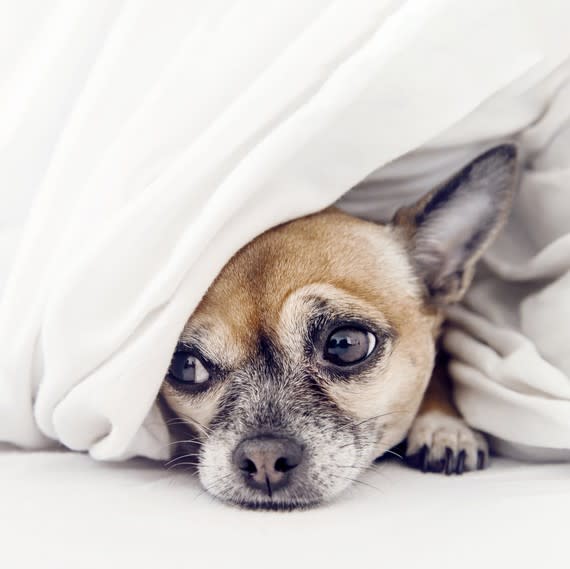How to Comfort a Pet That's Scared of Fireworks, Thunder, and Other Sudden Noises

Spring and summer weather bring much needed rain, but what if your pet fears thunderstorms? Sudden noise, flashes of lightening, hail, and the change in barometric pressure can turn fearful dogs and some cats into quivering mounds of fur. Pets that are afraid of thunder also frequently suffer from other noise phobias like fireworks fears, making Fourth of July celebrations anything but happy. In fact, more pets become scared and run away on Independence Day than any other day.
It's normal for pets to be cautious or feel fear they perceive a threat or danger. Once they recognize the absence of threat, the fear should go away. Some pets, though, suffer anxiety even when no threat is present. Phobia refers to the extreme fear reaction to no threat and can include sudden noises.
RELATED: The Best Calming Aids for Dogs and Cats
How Many Pets Fear Noise?
According to some surveys, up to 20 percent of dogs suffer from noise phobias. As many as 40 percent of dogs seen for behavior problems suffer from noise sensitivities. These pets not only feel miserable as they shiver and moan, they may hurt themselves diving through windows or chewing doors trying to get away from the scary situation. Noise phobias can develop at any age, but usually first appear in dogs older than a year. Puppies that miss out on proper early socialization and rescued dogs are at highest risk. A dog may fear storms and trucks backfiring, but not fireworks or the vacuum noise, or vice versa. Often, though, noise fearful dogs suffer anxiety from more than one thing.
Veterinary Help
Veterinarians used to prescribe a tranquilizer called Acepromazine for noise-phobic dogs. They've since discovered "Ace" potentially made fear worse, because dogs remained fearful but couldn't do anything about it. Today, much better medications (benzodiazepines) are available that reduce the fear or even make pets forget the scary trauma. The medication must be given in advance of the noise, though, which can be hard for pet parents to predict in the case of thunderstorms. Ask your veterinarian about options.
Desensitization and Counterconditioning
Other behavioral medications from your vet can help affected pets during desensitization programs that help reduce their fear. Desensitizing pets to noises involve exposing them to recorded sounds played at a such a low volume it doesn't frighten him. Over time, the noise level is increased so the dog learns it's not scary and can tolerate it. Along the way, the dog is given a high-value reward (a special treat or toy) for staying calm. This counterconditioning helps the dog to associate the noise with something fun and pleasant, rather than being scared. Desensitization and counterconditioning programs require months to work, though, and need the guidance of a professional. It's not particularly effective for storm phobias when dogs react to humidity or barometric pressure that you can't duplicate. Luckily, there are other things you can do at home to help your pet.
Appease the Fear
Dogs use scent to communicate, and an over the counter pheromone product works effectively to reduce canine fear. Comfort Zone with D.A.P. (dog appeasing pheromone) duplicates the "no-fear" pheromone mother dogs produce that keeps puppies calm. D.A.P. plug-in, sprays, and infused collars are available at pet products stores. Other dog pheromone products are also an option, so that when storms threaten or patriotic celebrations loom, be prepared.
Related: Four Things to Do Before You Adopt a Pet
Offer a Supplement
The supplement melatonin helps people reduce anxiety and relieve panic disorders and also can help noise-phobic dogs. Melatonin helps promote sleep, but doesn't sedate the dog. Melatonin can be found in health food stores, pharmacies, and some supermarkets. Always check with your veterinarian for the proper dosage for your dog.
Play Music
A white noise machine can help, and you can dial a radio between stations to create white noise. Playing "pet music" designed to calm dogs and cats also can help. Slow gentle rhythms calm pets by "entraining" the dog's heart, respiration, and brain waves to slow down and match the soothing rhythm. Harp music can be especially calming.
Reduce the Noise
Ear covers that muffle the sound may reduce your dog's fear. Products like Mutt Muffs (canine headphones) or Happy Hoodie (a doggy "snood") cover the dog's ears to reduce the sound. You can also use cotton balls temporarily to help muffle the noise. Just remove them after the noise subsides.
Dress Them Up
Fearful dogs often seek out tight-fitting places to hide. They squeeze between furniture and the wall or hide their eyes in your armpit. Never drag them out of these refuges and allow them to self-comfort in a hiding spot. You can also offer one of several cover-up products that offer relief to noise phobic dogs. The Storm Defender reduces static electricity created by thunderstorms that prompts some behavior problems. The Company of Animals' Anxiety Wrap applies even pressure to the dog's body and helps him better manage his stress. Thundershirt also applies pressure and is available cats as well a dogs. Some pets feel comforted by hiding their eyes, so the NACOCO's Calming Cap helps these dogs.
Some scared dogs want to be left alone, while others beg for your attention. It's fine to pet, talk, and cuddle your scared dog if he seems to ask for it. It won't make him more fearful and may comfort him. Using one or more of these tips should help him better deal with scary noises.
